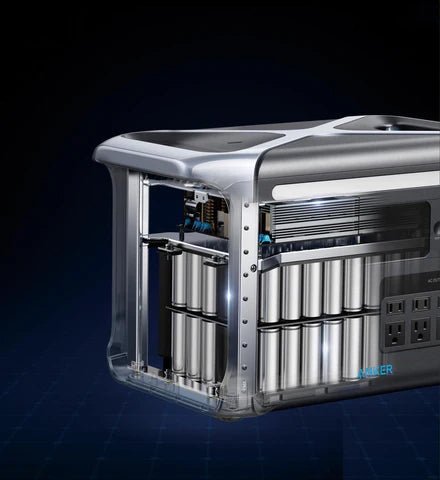
LiFePO4 Batteries: The Benefits You Need to Know
Eco PoweritShare
When shopping around for a portable power station, one of the most important considerations has to do with the type of battery inside. The wrong decision here could mean the difference between a power station that fizzles out after only a year – or one that endures through the next decade.
Most electronic devices, including portable power stations, have employed lithium-ion batteries as their energy source, which are commonly known for their usage in laptops, phones, and smaller power banks. However, the latest and greatest battery for consumer devices is lithium iron phosphate. This might at first seem like an insignificant spelling change, but it's an innovation that makes a world of difference. Read on to understand why.
What Are Lithium Iron Phosphate Batteries?
Before we talk about the advantages of lithium iron phosphate batteries, we must first understand their chemical distinctions compared to traditional batteries.
The most basic battery type we're all familiar with is the lead-acid battery, which has been around since the mid-1800s. Having no benefit for modern, portable devices, this antiquated tech has been gradually phased out and replaced with rechargeable lithium-ion batteries.
Lithium iron phosphate (LiFePO4 or LFP for short) batteries are not an entirely different technology, but are in fact a type of lithium-ion battery. There are many variations of lithium-ion (or Li-ion) batteries, some of the more popular being lithium cobalt oxide (LCO) and lithium nickel manganese cobalt oxide (NMC). These elements refer to the material on the cathodes and anodes (think the positive and negative ends of a battery), which is what the energy flows into or away from.
For the sake of this guide, we will lump every classic type of Li-ion battery together for easy comparison to LFP batteries. This will also simplify things for you as the consumer, because when it comes to portable power stations, there's LFP batteries... and then there's everything else.
Now that you know what to look for, let's dive into why LFP batteries are the essential element for reliable, portable power.
LIFESPAN
Perhaps the #1 reason to go with LFP batteries comes down to how long they'll last. When in doubt, check the name: LiFePO4 offers the longest Lifespan.
When we speak of battery lifespan, we’re generally referring to the number of complete charge cycles it’s rated for. A full charge-discharge cycle means bringing the battery from 100% down to 0% and then recharging back to full. This process can only be done a finite amount of times before the battery’s health reaches a threshold where it can no longer hold its full charge. This threshold is around 80% battery health.
A standard Li-ion battery can go through roughly 500 charge cycles until it reaches 80% health; after this point, the battery will gradually degrade until it is completely depleted and will no longer sustain a charge.
LFP batteries on the other hand, like the ones found in Anker portable power stations, will last for at least 3,000 charge cycles. This means that under everyday use, you can expect a PowerHouse to reliably serve you for the next 10 years—and likely far beyond.
VALUE
Given the much longer lifespan of LFP batteries, it’s obvious the tremendous value they hold compared to Li-ion.
A common misconception with LiFePO4 is that you’re paying a higher premium compared to traditional batteries. Despite the fact that LFP batteries are now comparatively the same price, let’s entertain that notion anyway and say that lithium iron phosphate does cost a premium. However, when you factor in the greater lifespan, durability, and dependability of LFP, it becomes clear that you’re actually saving money in the long run.
Let’s put it this way. Say you’re comparing an LFP portable power station to one that’s Li-ion. All the features, specs, and price are exactly the same. Yet, one of these will last 10+ years; the other may last, at best, 3 years. Which one would you choose? Exactly.
DURABILITY
Going hand-in-hand with lifespan is lithium iron phosphate's extreme durability. In addition to the sturdy, drop-proof exterior design of an Anker PowerHouse, the LFP batteries inside the unit feature their own form of resilient engineering, which can withstand many harsh conditions.
The true marker of a battery's durability is temperature. Li-ion batteries often struggle to hold a charge in extreme cold, and their battery life quickly deteriorates when exposed to heat. This is largely to do with the metals used in their cathodes, which we'll cover later. With LFP batteries, however, temperature is almost a non-issue. They can be reliably discharged and recharged with minimal degradation anywhere between 32℉ and 120℉.
If you try to operate the portable power station far outside this temperature range, the battery management system (BMS) will cleverly decide to shut the system down in order to protect the batteries. If this safety measure wasn't in place, then the batteries would be at much higher risk of failing—or even combusting. A well-designed BMS, paired with LFP batteries, therefore greatly adds to a portable power station's overall durability.
EFFICIENCY
Battery efficiency is important for a number of reasons. The hope is that the product you buy will perform as you expect it to. Compared to the abysmal 80% efficiency of lead-acid batteries, LFP batteries operate at 98% efficiency—meaning if 10 amps go in, then 9.8 amps will discharge.
This applies to recharging as well. Due to recent advancements in efficiency with LFP batteries, recharge times are now drastically reduced, to where a huge-capacity Anker 757 PowerHouse can be recharged in just over an hour. Talk about a major quality-of-life improvement!
The benefits continue when we consider a battery’s state of charge. In layman’s terms, this determines how well a battery stays charged under workloads. When a lead-acid battery is discharged, its voltage simultaneously lowers in a mostly linear fashion. This means that, as the energy requirement increases, its capacity lowers along with it. LFP batteries have an almost completely steady state of charge, so the voltage stays the same no matter what it’s charging. Essentially, you’re getting the exact battery capacity as advertised, no matter the situation.
Finally, efficiency can be measured by the size, weight, and portability of the battery. A high energy density means that more battery capacity can fit into a smaller size, which makes LFP batteries such an excellent option for mobile power.
But can there be too much of a good thing? Certain Li-ion battery chemistries like LCO and NMC actually offer a higher energy density than LFP. This comes at a trade-off, however. When delivering high currents, their chemical makeup is more volatile and prone to overheating in small enclosures, leading to serious safety concerns—an issue we'll get to shortly. For the perfect balance of size, efficiency, and reliability: LiFePO4 is the way to go.
SAFETY
We've all heard the horror stories in the news: rechargeable devices (we won't name brands) suddenly exploding without warning, causing danger and mayhem anywhere at anytime.
A scenario like this might seem incredulous and rare, but questions of safety are indeed a legitimate concern for us all. That's why it is critical that the portable power station you buy must be trustworthy and offer reliable peace of mind.
Not to stoke your fears too much, but the Li-ion batteries commonly found in many brands are quite susceptible to this type of worst-case nightmare. While the aforementioned battery management systems have built-in fail-safes to help prevent a situation like this, the unavoidable culprit here is battery chemistry.
The cobalt used in Li-ion cathodes is a very reactive metal. Under stressed conditions, it can react violently to the oxygen in the air, leading to potential fires or even explosions. Typically, battery fires result from the following causes: poor cooling or an external fire in the environment; overcharging, which leads to overheating; physical damage to the battery; or internal short circuiting from a defective or deteriorated battery.
When a battery crosses this danger zone, a chain reaction occurs called thermal runaway. Here, the stressed battery releases heat, which causes a rise in temperature, which in turn causes the battery to heat up even more... on and on until this volatile cycle reaches a climactic meltdown.
Luckily, LFP batteries do not contain cobalt—nor any flammable materials for that matter. They are highly resilient to oxygen loss, and they won't enter thermal runaway conditions until well past 300 degrees Celsius. So unless you're camping on Venus, you can sleep soundly next to an LFP portable power station.
In conclusion, LiFePO4 is one of the most stable battery chemistries available. Combined with strict testing standards performed by a reputable company – and you have a portable power station that's perfectly safe for your home or RV.
CLEAN & GREEN
Lastly, a good reason to go with lithium iron phosphate is for its minimal impact on the environment. The materials used in its construction are non-toxic and can be easily recycled or even repurposed into new batteries.
Conversely, lithium-ion batteries contain metals like nickel, cobalt and manganese, which are dangerous to the environment – not to mention unsustainable and harder to supply.
For a portable power station built with the cleanest and most renewable materials: you owe it to yourself, your family, and the planet to go with LiFePO4.
LiFePO4 for Any Situation
With a better understanding of LFP's many benefits, it should be obvious now which type of portable power station to go with. And for power that's long-lasting, valuable, durable, efficient, safe, and clean: there's an Anker PowerHouse for any need.
https://us.anker.com/blogs/content/lifepo4-batteries-the-benefits-you-need-to-know?_ga=2.150961142.1372129557.1673925083-549738922.1673766585
